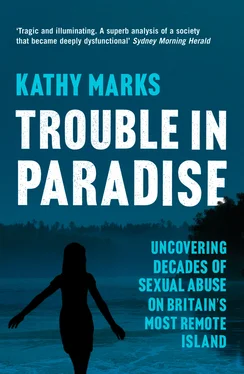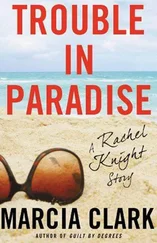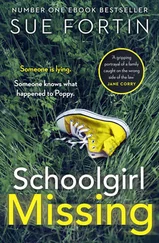At the Lodge, our other next-door neighbour was Len Brown, the oldest of the seven defendants. Len, who was charged with two rapes, was 78 and quite deaf, but still cut a physically imposing figure. Soon after we arrived, we saw him sitting in his garden, working on a carved replica of the Bounty —one of the wooden souvenirs that the islanders sell to tourists. For reasons unclear, a rusting cannon from the real ship stood on Len’s front lawn.
The mutiny on the Bounty is one of the most notorious events in British maritime history. Yet it was only one of a series of rebellions against the British Navy in the late 18th century. One uprising in 1797 involved dozens of ships and a blockade of London. Another led to the murder at sea of a captain and eight of his officers.
That few people are familiar with these incidents, while nearly everyone knows about the drama on board the Bounty , can be explained in one word: Hollywood. The mutiny inspired five films between 1916 and 1984, three of them made by American studios, with Fletcher Christian played by matinée idols such as Clark Gable, Marlon Brando and Mel Gibson. Studio bosses loved the story, with its exotic South Seas setting, scenes of swashbuckling adventure and cast of semi-naked Polynesian maidens, and so did generations of cinemagoers, who warmed to Christian and sided with him against the apparently cruel and sadistic Captain William Bligh. The mutineers’ descendants mostly shared that view of Bligh as the villain and Christian as the dashing young hero; to this day, they will not hear a word against their infamous ancestor.
The historical background is more complex than Hollywood has allowed. And it all began with breadfruit, a large, globe-shaped fruit.
Breadfruit trees had been discovered in Tahiti in 1769 by Sir Joseph Banks, the English naturalist, who urged King George III to introduce them to the West Indies as a cheap food source for slaves on the sugar plantations. The King appointed Bligh, a Royal Navy lieutenant, to lead an expedition, and in December 1787 a 220-ton former merchant ship, His Majesty’s Armed Vessel Bounty , set sail from Portsmouth with 46 officers and men. Among them was Fletcher Christian, the master’s mate and, effectively, Bligh’s chief officer.
Bligh was an ambitious 33-year-old, and an outstanding navigator who had accompanied Captain James Cook on his final voyage. Christian was 23, equally ambitious, and from a genteel—albeit no longer wealthy—family with strong links to the Isle of Man. He had sailed twice previously under Bligh, who regarded him as a friend and protégé.
The plan was to head to Tahiti via South America, collect some breadfruit saplings and transport them to the Caribbean. However, the Bounty ran into atrocious weather at Cape Horn, after which Bligh elected to go east, taking the longer route. The ship reached Tahiti’s Matavai Bay in October 1788.
Early European visitors had called the island an earthly paradise, and after nearly a year at sea the Englishmen could only agree. Tahiti’s white beaches were caressed by warm breezes; its trees hung heavy with fruit and its lagoons teemed with fish. The native men treated the sailors as ‘blood brothers’, while the beautiful, uninhibited women showered them with attention. Six months later, when it was time to depart, no one except the puritanical Bligh was keen to resume the rigours of shipboard life.
Bligh was convinced that it was Tahiti’s charms, so reluctantly relinquished, that triggered the events of 28 April 1789. Most historians now agree that, far from being a brutal despot, Bligh was an enlightened captain who kept his crew healthy and flogged only sparingly. But he was also prone to fly into rages. After the Bounty left Tahiti, he humiliated the thin-skinned, volatile Christian, branding him a coward and accusing him of stealing coconuts from a stash on deck. Their relationship had broken down—although probably not as a result of a gay liaison gone sour, as some have speculated.
Three weeks out of Matavai Bay, as the Bounty approached the Friendly Islands (now called Tonga), five men burst into Bligh’s cabin at dawn. With Christian pointing a bayonet at his chest, Bligh was made to climb into the ship’s launch, along with 18 loyal officers and men. He appealed to Christian, reminding him, ‘You have danced my children upon your knee.’ The latter, reportedly in a delirious state, replied, ‘That, Captain Bligh, that is the thing … I am in hell … I am in hell.’
Bligh and his followers were set adrift with no charts and only meagre supplies. In a remarkable feat of navigation, Bligh guided the launch across 3618 miles of open sea, landing on the island of Timor 48 days later. Amazingly, only one life had been lost: that of a quartermaster, killed not at sea but in a skirmish with Tongans. In Batavia (now Jakarta), Bligh found a berth on a Dutch East Indiaman, and in March 1790 he arrived back in England, where he recounted his tale to an astonished nation.
The mutineers, meanwhile, were searching for a refuge. They could not go home to England, and an attempt to settle on Tubuai, 400 miles south of Tahiti, was abandoned after clashes with the locals. The men split into two factions. Sixteen of them decided to chance their luck on Tahiti; the other nine, led by Christian, would continue their quest. The Bounty dropped the first group at Tahiti, but picked up some new passengers: 12 Polynesian women, six Polynesian men and a baby accompanied Christian’s band on their journey.
Two months later, while flicking through a book in Bligh’s library, Christian noticed a reference to ‘Pitcairn’s Island’. The island sounded promising, but it had been incorrectly charted, and another two months passed before he finally sighted it in January 1790. Christian led a party ashore, and when he returned he was smiling for the first time in weeks. Pitcairn was not only off the map, but it was also unpopulated, and it was a natural fortress—thickly forested, with towering cliffs and no safe anchorage. Yet it had fertile soil, fruit trees and (unlike now) a water source. The mutineers ran the Bounty aground and prepared to establish a new community far from civilisation.
The sailors divided the cultivable land into nine plots, one for each of them. The proud Polynesian men, who had been their friends and equals on Tahiti, received nothing; instead they were to be their servants. The Englishmen also took one ‘wife’ apiece, with the other three women shared among the six Tahitians. These actions created a deadly stew of sexual jealousy and racial resentment, which boiled over two years later.
After the wives of John Williams and John Adams died, the pair commandeered two of the Polynesians’ women. Enraged, the native men hatched a plot to murder the mutineers. But the latter were tipped off, and it was two Tahitians who were killed, one of them by his former wife.
In 1793 violence flared again. The four remaining Polynesian men stole some muskets, and within the space of one day murdered five Englishmen, including Fletcher Christian. Only John Adams, William McCoy, Matthew Quintal and Edward Young survived. Tit-for-tat killings followed, by the end of which all the Tahitian men were dead.
Calm then descended on the community—until 1798, when McCoy built a still and began producing a powerful spirit from the roots of the ti-plant. The men, and some of the women, spent their days in a drunken stupor, and it was in such a state that McCoy threw himself off a cliff. Quintal grew increasingly wild, and tried to snatch Young’s and Adams’ wives; the pair decided that they had no option but to kill him. They hacked Quintal to death with a hatchet. At last the cycle of bloodshed was over.
Читать дальше












